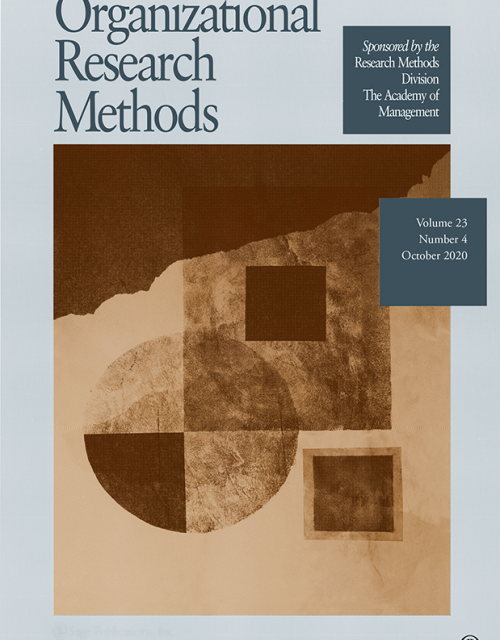Publication records
Subject(s)
Management sciences, decision sciences and quantitative methods
Keyword(s)
Social network analysis, network dynamics, Relational Events Model
The Relational Event Model (REM) solves a problem for organizational researchers who have access to sequences of time stamped interactions. It enables them to estimate statistical models without collapsing the data into cross-sectional panels, which removes timing and sequence information. However, there is little guidance in the extant literature regarding issues that may affect REM’s power, precision and accuracy: How many events or actors are needed? How large should the risk set be? How should statistics be scaled? To gain insights into these issues, we conduct a series of experiments using simulated sequences of relational events under different conditions and using different sampling and scaling strategies. We also provide an empirical example using email communications in a real-life context. Our results indicate that, in most cases, the power and precision levels of REMs are good, making it a strong explanatory model. However, REM suffers from issues of accuracy that can be severe in certain cases, making it a poor predictive model. We provide a set of practical recommendations to guide researcher’s use of REMs in organizational research.
With permission of SAGE Publishing
Volume
24
Journal Pages
802–829
Subject(s)
Diversity and inclusion; Entrepreneurship; Human resources management/organizational behavior; Strategy and general management
Keyword(s)
contrarian, behavioural traps, diversity, strategy
ISSN (Print)
0017-8012
Keyword(s)
Price competition, price dispersion, unique equilibrium
JEL Code(s)
D43, L11
We study a canonical model of simultaneous price competition between firms that sell a homogeneous good to consumers who are characterized by the number of prices they are exogenously aware of. Our setting subsumes many employed in the literature over the last several decades. We show there is a unique equilibrium if and only if there exist some consumers who are aware of exactly two prices. The equilibrium we derive is in symmetric mixed strategies. Furthermore, when there are no consumers aware of exactly two prices, we show there is an uncountable-infinity of asymmetric equilibria in addition to the symmetric equilibrium. Our results show the paradigm generically produces a unique equilibrium. We also show that the commonly-sought symmetric equilibrium (which also nests the textbookBertrand pure strategy equilibrium as a special case) is robust to perturbations in consumer behaviour, while the asymmetric equilibria are not.
© 2021 The Editorial Board of The Journal of Industrial Economics and John Wiley & Sons Ltd
Volume
69
Journal Pages
595–614
Subject(s)
Diversity and inclusion; Strategy and general management
Keyword(s)
Diversity, random selection, luck
In the final decision-making process for an application, companies want to avoid mistakes at all costs. This article explains two reasons why you should trust chance instead.
Journal Pages
66
Subject(s)
Diversity and inclusion; Strategy and general management
Keyword(s)
Diversity, random selection, luck
When it comes to hiring, blind luck can trump biased reasoning and generate a less-is-more effect.
Subject(s)
Entrepreneurship; Strategy and general management; Technology, R&D management
Keyword(s)
Innovation, leadership, luck
Exceptional innovations are often attributed to brilliant strategies or leaders with superior foresight. But luck is in fact necessary for exceptional innovations in many ways.
ISSN (Print)
0015-6914
Subject(s)
Management sciences, decision sciences and quantitative methods; Product and operations management
Keyword(s)
Product proliferation, lead-time reduction, process redesign, delayed differentiation
Product proliferation occurs in supply chains when manufacturers respond to diverse market needs by trying to produce a range of products from a limited variety of raw materials. In such a setting, manufacturers can establish market responsiveness and/or cost efficiency in alternative ways. Delaying the point of the proliferation helps manufacturers improve their responsiveness by postponing the ordering decisions of the final products until there is partial or full resolution of the demand uncertainty. This strategy can be implemented in two different ways: (1) redesigning the operations so that the point of proliferation is swapped with a downstream operation or (2) reducing the lead times. To establish cost efficiency, manufacturers can systematically reduce their operational costs or postpone the high-cost operations. We consider a multi-echelon and multi-product newsvendor problem with demand forecast evolution to analyze the value of each operational lever of the responsiveness and the efficiency. We use a generalized forecast-evolution model to characterize the demand-updating process, and develop a dynamic optimization model to determine the optimal order quantities at different echelons. Using anonymized data of Kordsa Inc., a global manufacturer of advanced composites and reinforcement materials, we show that our model outperforms a theoretical benchmark of the repetitive newsvendor model. We demonstrate that reducing the lead time of a downstream operation is more beneficial to manufacturers than reducing the lead time of an upstream operation by the same amount, whereas reducing the upstream operational costs is more favorable than reducing the downstream operational costs. We also indicate that delaying the proliferation may cause a loss of profit, even if it can be achieved with no additional costs. Finally, a decision typology is developed, which shows effective operational strategies depending on product/market characteristics and process flexibility.
View all ESMT Working Papers in the ESMT Working Paper Series here. ESMT Working Papers are also available via SSRN, RePEc, EconStor, and the German National Library (DNB).
Pages
52
ISSN (Print)
1866–3494
Subject(s)
Finance, accounting and corporate governance
Keyword(s)
financial statement analysis, key performance indicators, financial statement key ratios, rating
Secondary Title
Betriebswirtschaft für Führungskräfte: Eine Einführung in betriebswirtschaftliches Denken und Handeln
Edition
5th ed.,
Pages
811–838
ISBN
978-3-7910-3760-8
ISBN (Online)
978-3-7910-4135-3
Subject(s)
Human resources management/organizational behavior
Keyword(s)
Executives, career shocks, coaching
This is a practitioner article based on a recently published academic paper on career shocks of executive. The article explains the phenomenon of a career shocks and offers strategies for dealing with them.
ISSN (Print)
0015-6914
Subject(s)
Finance, accounting and corporate governance
Keyword(s)
discounted cashflow, capital budgeting, net present value, monte carlo analysis, wacc, cost of capital, capital expenditure (CAPEX), business plan
Secondary Title
Betriebswirtschaft für Führungskräfte: Eine Einführung in betriebswirtschaftliches Denken und Handeln
Edition
5th ed.,
Pages
505–546
ISBN
978-3-7910-3760-8
ISBN (Online)
978-3-7910-4135-3
